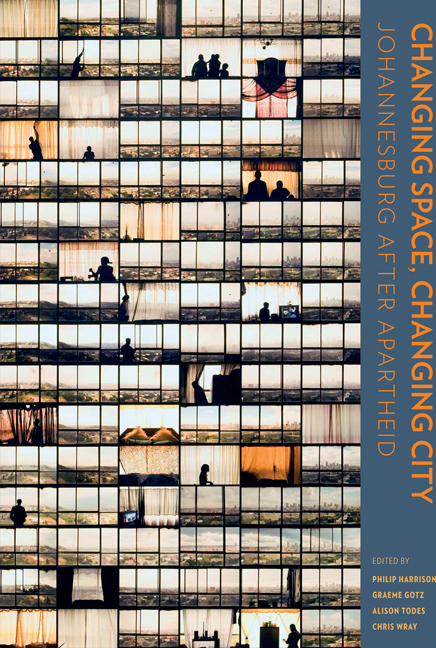Book contents
- Frontmatter
- Contents
- Preface
- Cartography
- 1 Materialities, subjectivities and spatial transformation in Johannesburg
- Section A The macro trends
- Section B Area-based transformations
- 12 Between fixity and flux: Grappling with transience and permanence in the inner city
- 13 Are Johannesburg's peri-central neighbourhoods irremediably ‘fluid’? Local leadership and community building in Yeoville and Bertrams
- 14 The wrong side of the mining belt? Spatial transformations and identities in Johannesburg's southern suburbs
- 15 Soweto: A study in socio-spatial differentiation
- 16 Kliptown: Resilience and despair in the face of a hundred years of planning
- 17 Alexandra
- 18 Sandton Central, 1969–2013: From open veld to new CBD?
- 19 In the forest of transformation: Johannesburg's northern suburbs
- 20 The north-western edge
- 21 The 2010 World Cup and its legacy in the Ellis Park Precinct: Perceptions of local residents
- 22 Transformation through transportation: Some early impacts of Bus Rapid Transit in Orlando, Soweto
- Section C Spatial identities
- Contributors
- Photographic credits
- Acronyms
- List of plates
- List of figures
- List of tables
- Index
20 - The north-western edge
from Section B - Area-based transformations
Published online by Cambridge University Press: 20 April 2018
- Frontmatter
- Contents
- Preface
- Cartography
- 1 Materialities, subjectivities and spatial transformation in Johannesburg
- Section A The macro trends
- Section B Area-based transformations
- 12 Between fixity and flux: Grappling with transience and permanence in the inner city
- 13 Are Johannesburg's peri-central neighbourhoods irremediably ‘fluid’? Local leadership and community building in Yeoville and Bertrams
- 14 The wrong side of the mining belt? Spatial transformations and identities in Johannesburg's southern suburbs
- 15 Soweto: A study in socio-spatial differentiation
- 16 Kliptown: Resilience and despair in the face of a hundred years of planning
- 17 Alexandra
- 18 Sandton Central, 1969–2013: From open veld to new CBD?
- 19 In the forest of transformation: Johannesburg's northern suburbs
- 20 The north-western edge
- 21 The 2010 World Cup and its legacy in the Ellis Park Precinct: Perceptions of local residents
- 22 Transformation through transportation: Some early impacts of Bus Rapid Transit in Orlando, Soweto
- Section C Spatial identities
- Contributors
- Photographic credits
- Acronyms
- List of plates
- List of figures
- List of tables
- Index
Summary
A key objective of Johannesburg's strategic spatial planning has been to promote more compact development, limiting growth on the urban periphery. However, there has been considerable pressure for growth close to and beyond Johannesburg's defined urban development boundary (UDB), and in adjacent municipalities. Some 56 per cent of major land-use conversions from open space to other uses in Johannesburg and the area 5 km around it over the 2004–2007 period occurred within neighbouring municipalities, and significant development took place in areas close to, but still inside of, Johannesburg's UDB, especially in the north and north-west (see Figure 20.1). These trends suggest that Johannesburg increasingly needs to be seen in a broader city-region context. However, growth on Johannesburg's periphery and beyond is not merely a question of continuous incremental expansion in search of cheaper land. Rather, dynamics are complex and variable across areas, and processes of growth have been highly contested (Chipkin 2012).
However, unlike other work that has focused on the periphery, particularly the northwestern edge of the city and the newly constituted ‘political relationship’ between the state and communal forms of ownership offered by sectional title units and cluster houses (Chipkin 2012), in this chapter we focus on patterns of growth in specific parts of the north-west since the 1990s, explaining the various drivers and dynamics of change. We consider the differing objectives and intentions of the City of Johannesburg and its neighbouring municipality of Mogale City, as well as of provincial authorities; the role of formal regulatory and legal processes, and of more informal political processes; the pressures by different groups of developers to allow growth beyond the UDB; the influence of environmental groups and existing residents in constraining development; responses to the growth of informal settlements; and the diverse visions for development in the area.
We begin by providing an overview of development trends in the area, and then move in an arc from west to east, discussing the cases of Ruimsig, where the UDB itself has been a focus of contestation; the broader Muldersdrift area, including the Cradle of Humankind and informal and housing areas within Johannesburg, where conflicts have centred around tourism-development-conservation-nimbyism axes; and the planning for large-scale development in Lanseria.
- Type
- Chapter
- Information
- Changing Space, Changing CityJohannesburg after apartheid, pp. 418 - 436Publisher: Wits University PressPrint publication year: 2014



